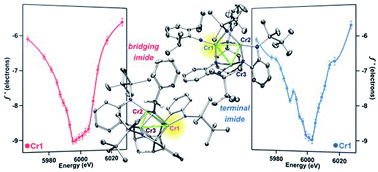Revealing redox isomerism in trichromium imides by anomalous diffraction†
Abstract
In polynuclear biological active sites, multiple electrons are needed for turnover, and the distribution of these electrons among the metal sites is affected by the structure of the active site. However, the study of the interplay between structure and redox distribution is difficult not only in biological systems but also in synthetic polynuclear clusters since most redox changes produce only one thermodynamically stable product. Here, the unusual chemistry of a sterically hindered trichromium complex allowed us to probe the relationship between structural and redox isomerism. Two structurally isomeric trichromium imides were isolated: asymmetric terminal imide (tbsL)Cr3(NDipp) and symmetric, μ3-bridging imide (tbsL)Cr3(μ3–NBn) ((tbsL)6− = (1,3,5-C6H9(NC6H4-o-NSitBuMe2)3)6−). Along with the homovalent isocyanide adduct (tbsL)Cr3(CNBn) and the bisimide (tbsL)Cr3(μ3–NPh)(NPh), both imide isomers were examined by multiple-wavelength anomalous diffraction (MAD) to determine the redox load distribution by the free refinement of atomic scattering factors. Despite their compositional similarities, the bridging imide shows uniform oxidation of all three Cr sites while the terminal imide shows oxidation at only two Cr sites. Further oxidation from the bridging imide to the bisimide is only borne at the Cr site bound to the second, terminal imido fragment. Thus, depending on the structural motifs present in each [Cr3] complex, MAD revealed complete localization of oxidation, partial localization, and complete delocalization, all supported by the same hexadentate ligand scaffold.



 Please wait while we load your content...
Please wait while we load your content...